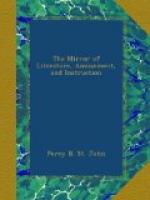Stowe, in his Annals, accounts for the origin of touching for the evil, in the following manner:—“A young woman who was afflicted with this disorder in a very alarming manner, and to a most disgusting degree, feeling uneasiness and pain consequent upon it in her sleep, dreamt that she should be cured by the simple operation of having the part washed with the king’s hand. Application was consequently made to Edward, by her friends, who very humanely consented to perform the unpleasant request. A basin of water was brought, with which he carefully softened the humours, till they broke, and the contents discharged; the sign of the cross wound up the charm; and the female retired, with the assurance of his protection during the remainder of the cure, which was effected within a week.” This is somewhat differently related in Ailred’s History of the Life and Miracles of Edward the Confessor, an extract from which may be found in a note to the first volume of Rapin’s History of England.
The following curious advertisement was issued by the order of King Charles II. for healing the people, on the 18th of May, 1664.
“Notice.
“His sacred majesty having declared it to be his royal will and purpose to continue the healing of his people for the evil during the month of May, and then give over till Michaelmas next; I am commanded to give notice thereof, that the people may not come up to the town in the interim, and lose their labour.”
Thomas Mousewell was tried for high treason in 1684, for having spoken with contempt of King Charles’s pretensions to cure the scrofula.
In a manuscript account of the Restoration, written by Thomas Gumble, D.D. Chaplain to General Monck, in the year 1662, is the following description of the ceremony:—” There was a great chair placed for the king, in a place somewhat distant from the people. As soon as the king was sate, one of the clerks of the closet stood at the right side of his chair, holding on his arm as many gold angels (every one tied in a ribbon of white silk) as there were sick to be touched, which were in number, forty-eight. Dr. Brown, the chaplain of the Princess of Aurange, performed the place of the king’s chaplain. The chaplain then read the sixteenth chapter of St. Mark, from the fourteenth verse to the end; and then the chirurgeon presented the sick, (having examined them to see that it was the evil) after three reverences on their knees, before the king, who, whilst the chaplain said these words in that gospel: ’They shall lay their hands upon the sick, and they shall be healed,’ layed his hands on the two cheeks of the sick, saying, ’I touch thee, but God healeth thee!’ The chaplain then began another gospel; and whilst these words were pronounced out of the first chapter of St. John: ’This was the true light which lighteth every man that cometh into the world,’ his majesty took the pieces of gold, and put them on the necks of the diseased, the chaplain repeating the words as many times as there were persons to receive them, concluding with a prayer, ’That Almighty God would bless the ceremony;’ then, after the reverences as before, they retired. The Earls of Middlesex and St. Albans held the bason, ewer, and towel, whilst the king washed.”




